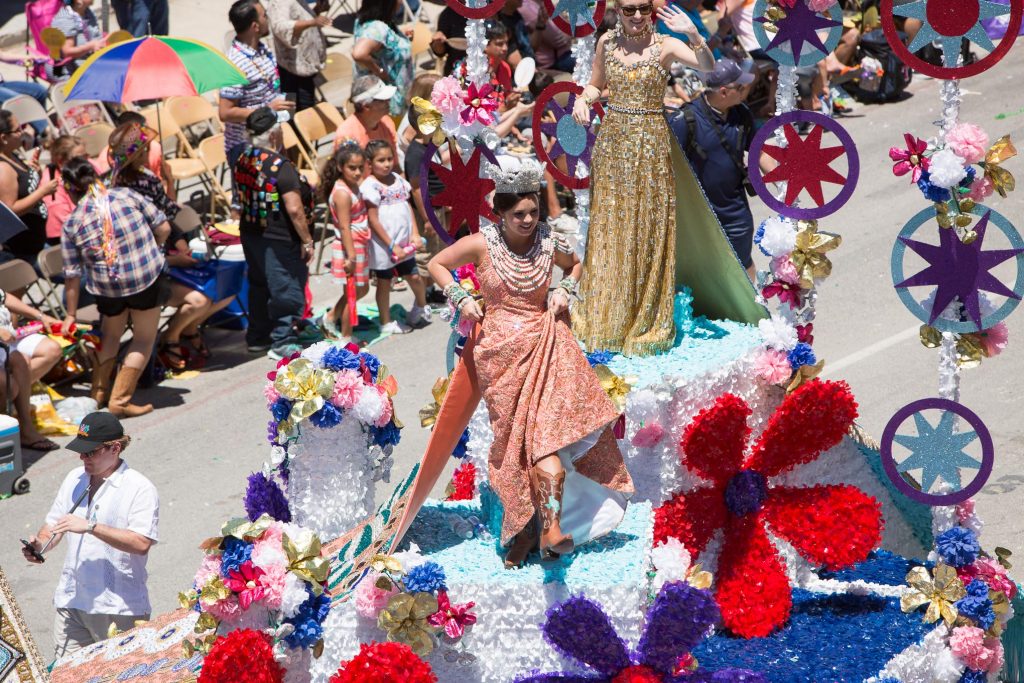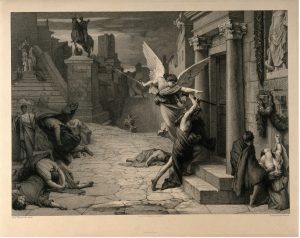Colorful floats; streets closed with barricades; people covering the sidewalks and setting up their lawn chairs to have a good view, having the day off from school; the Marching Bands from High Schools and Universities, decorating their instruments with ribbons, preparing their formation under Highway 37 on Grayson Street; the Fiesta Royalty putting on their best pairs of decorated shoes before stepping onto their throne, mounted on one of the biggest of the parade floats. If you’re a native San Antonian, you know exactly what grand celebration is about occur and what has been going on for the days before; it is part of Fiesta, the ten-day city-wide celebration; it is the Battle of Flowers parade. The Battle of Flowers is a 2.6-mile parade that runs through downtown San Antonio, typically one of the closing events of the Fiesta celebration. This Parades begins on the edge of downtown, and continues onto three major streets: Broadway, Alamo, and Commerce.1 Local schools participate in this parade; their dance troops, mariachi bands, ROTC, and Marching Band programs participate and walk the parade alongside the Texas Cavaliers, the Fiesta Royalty, and the Mayor. Although this annual event has become a hallmark for San Antonians, many don’t know how or when it all began. Let’s go back to its origins, back to the last decade of the nineteenth century in San Antonio.

Originating in 1891, the Battle of Flowers parade was created as a tribute to all those who fought and who fell at the Battles of San Jacinto and the Alamo.2 The idea of a grand celebration to commemorate these heroes came from a tourist, the native-Chicagoan W. J. Ballard. He believed that a proper tribute should be made, and asked a group of local ladies why this had not been the case just yet. His question extended through the city and made its way into newspapers and gained the approval of the community almost instantly. The anticipated idea aroused a spark of interest in Ellen Maury Slayden, a native Virginian elite, who had found her way to San Antonio by marriage to a merchant and later congressman, James L Slayden. Slayden then decided to bring Ballard’s idea to life, and since she knew it was almost impossible on her own, she decided to enlist the help of another newcomer to the area, J. S. Alexander. They both decided to take this on as a pet project of theirs, with the help and support of their husbands. Alexander, a banker before arriving in Texas, provided information on some familiarity he had had overseas about seeing a parade surrounded by flowers, where carts were decorated with flowers. Slayden also remembered similar instances in celebrations she knew about across Mexico and Spain, giving the basis for what the parade would become. The husbands, and many of the elite men of San Antonio, took over the project and had gentlemen speak on behalf of the ladies at the committee meetings; however, as the project grew, the ladies wanted to make sure that it was still a women’s project and continued to provide input and ideas, thus creating the Battle of Flowers Association.3

The parade was originally intended to be an April 21st celebration to celebrate the 55th anniversary of the victory of the Battle of San Jacinto; however, coincidentally, San Antonio was just then expecting its first-ever visit from the White House, the 23rd president of the United States, President Benjamin Harrison. As soon as word got out, the city became ecstatic and prepared a celebration to welcome the President, including moving the parade a day ahead of its original date. With the dates set in stone, the first official planning committee meeting took place only a mere seven days prior to the event. They were frantically trying to gather flowers from nearby towns, since San Antonio had just experienced some heavy rains, which had destroyed most flower gardens, leaving the city with a shortage of flowers just before the parade. Trains were rushed in with shipments of flowers from nearby towns. Other means of making up for the shortage were discussed as well, such as dressing the children up as flowers and having bicyclists decorate their mobiles with whatever blossoms they found and join the parade.4 In the days leading up to the parade, everything seemed all set to go, except for the weather. The city had been plagued with days of heavy rain, and the whole city was hopeful that the rains would cease as the day approached; however, they were wrong. On the morning of the parade, the rains didn’t have mercy on their plans, and as the President’s train arrived, the downpour became continuous. But the rains didn’t stop the city from providing the President with a warm welcome; however, it did postpone the flower parade for the following week, which, of course, would mean that the President would be long gone by then. When the warm weather finally arrived the following week, the parade went as planned; and it was so successful that the committee pushed to have it continue as an annual celebration. It has since been celebrated since 1891, except for the years during World Wars I and II.5

By 1985, the parade continued to grow into the week-long celebration known today as Fiesta. And as the years went by, Kings and Queens were elected as Fiesta Royalty.6 The Parade continues to grow, and so does its recognition across the city and the state. It is now funded by private associations. To this day the parade is one of the closing events of the city-wide, week-long Fiesta party and continues to generate community involvement. Every April, San Antonio puts on a fantastic show, and without a doubt, it all goes back to a Chicagoan tourist, two ladies, and one united community.

- Battle of Flowers, Official Website: Battle of Flowers About us (battleoflfowers.org, 2018). ↵
- Handbook of Texas, June 2010, s.v “Fiesta San Antonio,” by Mrs. Willard E. Simpson, Jr. ↵
- Jack Maguire, A Century of Fiesta in San Antonio (Austin, Texas: Eakin Press, 1990), 13-15. ↵
- Jack Maguire, A Century of Fiesta in San Antonio (Austin, Texas: Eakin Press, 1990), 17. ↵
- Jack Maguire, A Century of Fiesta in San Antonio (Austin, Texas: Eakin Press, 1990), 17; Laura Hernandez-Ehrisman, Inventing the Fiesta City, Heritage and Carnival in San Antonio (New Mexico Press,2008), 21. ↵
- Handbook of Texas, June 2010, s.v. “Fiesta San Antonio,” by Willard E. Simpson, Jr. ↵



117 comments
Maricela Guerra
As someone from San Antonio I really enjoyed this article. It was bright and popping with full of information. The fact that the article was based on the parade was great, the whole time I was reading I could relate to some of the text, and also be fascinated with the information I did not know as well. Overall the author did a very good job in this article.
Vanessa Tombo
Living in Texas for 10 years I have always celebrated the culture and traditions around me. However, prior to reading this article, I did not know of the historical component of the involved in the parade battle of the flowers. I remember making shoe box floats at school and walking in a mini-parade at the elementary school I attended. Until now I did not know of its significance.
Miguel Camarillo-Cohen
This article provides a good overview of how the parade and ultimately Fiesta started in San Antonio. It mentions historical points that lead to the formation of the Battle of the Flowers in 1891 as a tribute to those who fought at the Battles of San Jacinto and the Alamo. It is missing the history that addresses two points: 1. The current tension between those who want to celebrate the Alamo and those who were part of the Mexican contributions to Texas. 2. History related to the border crossing “Texas”.
While the Battle of the Flowers, is really a story about the Battle for the Alamo, and there is a conflict today hardly ever mentioned, Fiesta raises hundreds of dollars for local nonprofits and universities including St. Mary’s through the Oyster Bake.
Jose Figueroa
Just how you mentioned, I am on of the San Antonians that had no idea where the parade came from. I find it especially interesting how the project really executed by woman and how they emphasized there role in it by creating the Battle of Flowers association. The author did a great job giving the history behind the Battle of Flowers parade while giving us vibrant images to pair with the facts. Great job!
Joshua Castro
I found this to be such a fun article! Since I have grown up in San Antonio, my earliest memories consist of watching all the floats, bands, and schools marching by! Reading about the history and origins behind this amazing city’s biggest and most beautiful event is always guaranteed to be a captivating story. From these origins, the color and vibrance of this city and it’s people will remain shining for generations to come as it is passed down to one another.
Austin Pena
Great article. Being a San Antonio native i feel bad for not knowing the origin of the parade, but it great to see an article about something special to our city. With fiesta coming up this article was a perfect read to educate those (like myself) who might not know the history of the parade. Fiesta is such a great time for the city and with it coming up i would just like to say to stay safe if attending any of the events.
Isaac Rodriguez
I really enjoyed the article because it focused on a bit of history relating to San Antonio. Despite living here my entire life, I had not known the history behind the Battle of Flowers parade. I was surprised to learn that the parade, was not named after an actual battle and that it has been around since 1891. With fiesta week coming up, I may consider attending the parade for the first time.
Iris Henderson
I really enjoyed learning this beautiful story about how the Battle of Flowers came to be. I especially liked that the idea came from a tourist, later coming into existence by other non native residents. I think that this story shared an aspect of people coming together, celebrating culture, while making new traditions. This was an excellent topic to cover!
Erin Vento
I’m so glad I read this article because my friends and I were just talking about the Battle of Flowers, and because none of us are from here, we didn’t know what it was. The parade looks so beautiful and the history behind it is so cool; I didn’t think that Fiesta grew around the parade. This article definitely made me more excited to see it in person!
Tyler Thompson
This was a very interesting article, and it’s nice to be able to actually see this parade. Although most of the flowers have been destroyed due to all of the flooding and such, it was very nice to see that the surrounding cities appreciated the San Antonio culture and supplied many flowers for them. It’s amazing that the culture is still very respected and continues to become better as time continues.